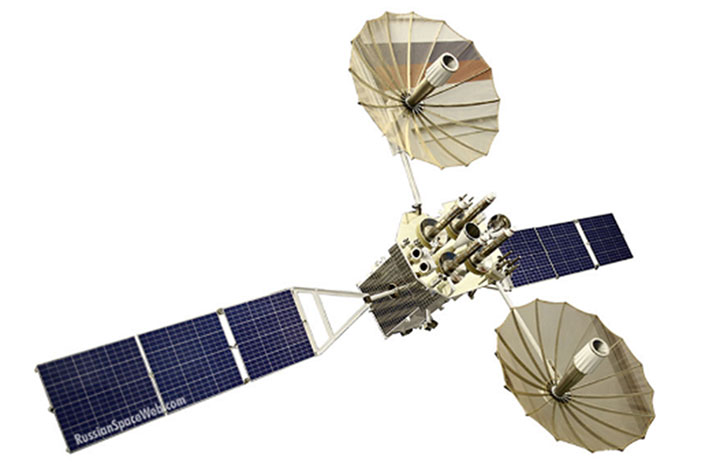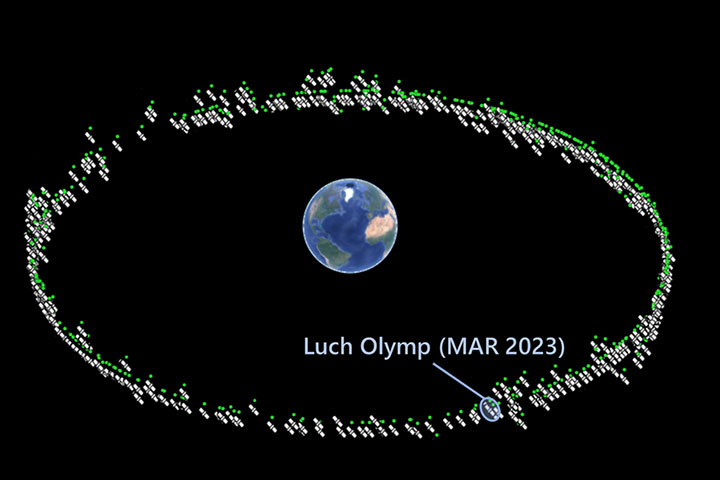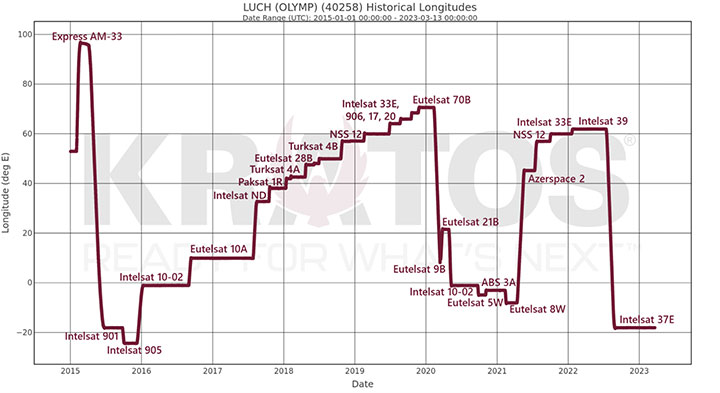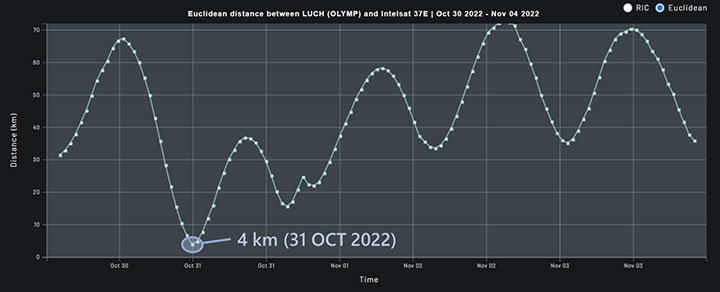COLORADO SPRINGS — A spy is among us. He tries to blend in, but his actions betray his true identity. He gravitates toward the important people in the room, casually sliding into their conversations. He disregards norms of personal space and privacy. He’s always listening, always watching.
The spy’s name is Luch Olymp, a.k.a Olymp-K (Олимп-К). He hails from Russia but is currently operating in geosynchronous Earth orbit, in the vacuum of space 35,000 km overhead.
Luch Olymp is no ordinary satellite. It exhibits unusual behavior which hints at its mission: espionage. Space security organizations have monitored Luch Olymp for almost a decade and most agree it is a signals intelligence (SIGINT) collection device operated by the Russian government. Like the infamous SIGINT balloon China flew over the United States in 2023, Luch Olymp’s actions have captured the attention of Western governments and landed it on a few “Most Wanted” lists.
Unusual Patterns of Behavior
When Luch Olymp launched from Kazakhstan in September 2014, little was known about its mission. By using the name “Luch,” the Russian Space Agency ostensibly identified the satellite within a group of five civilian data relay satellites, also called Luch, used to communicate with cosmonauts on the International Space Station. However, other sources in Russia named the satellite “Olymp,” hinting at a different mission. Additional reports out of Russia confirmed a dual military mission of SIGINT and secure communications for government use, suggesting the Luch name was merely camouflage.
 Figure 1 – An example of a Luch data relay satellite. (Source: RussianSpaceWeb.com)
Figure 1 – An example of a Luch data relay satellite. (Source: RussianSpaceWeb.com)
Once in orbit, Luch Olymp’s patterns of behavior confirmed it was more than a data relay device. Satellites in GEO move in sync with Earth’s rotation. They normally appear stationary in the sky, like jewels fixed on a circular belt around the equator. Each satellite is assigned a unique orbital slot, a specific longitude serving as that satellite’s permanent home.
The other five satellites in the Luch constellation stay locked to their orbital slots, as expected, but not Luch Olymp, which roves around the GEO belt in fits and starts. It maneuvers extremely close to other satellites, stops for a few days or weeks, then maneuvers to another location. These repeated close approaches have convinced experts of Luch Olymp’s SIGINT mission.
 Figure 2 – A diagram of satellites in geosynchronous (GEO) orbit. (Source: Kratos)
Figure 2 – A diagram of satellites in geosynchronous (GEO) orbit. (Source: Kratos)
SIGINT 101: Signals Interception
Intercepting RF signals requires carefully positioning an antenna to receive some of the energy traveling between the transmitter and receiver. To intercept satellite uplinks, a collection device is placed as close as possible to the target satellite. Luch Olymp’s temporary incursions into each orbital slot give it a perfect position to eavesdrop. After parking near a satellite, RF collection is as simple as tuning equipment to match the channels in use, recording an appropriate duration, then downlinking the recording home to eager recipients on the ground.
Even while “parked” near a target satellite, Luch Olymp does not stop moving. The physics of orbital dynamics dictate a constant motion relative to the other spacecraft. Figure 3 illustrates this repeating dance. The pink curve tracks Luch Olymp’s position over two days relative to Intelsat 37E, shown as an orange dot. At different times through this period, Luch Olymp finds itself above, below and beside Intelsat 37E. These varied orientations provide ideal opportunities for RF and optical intelligence gathering.
 Figure 3 – Luch Olymp (pink) and Intelsat 37E (orange) relative positions. (Source: Kratos Global Sensor Network)
Figure 3 – Luch Olymp (pink) and Intelsat 37E (orange) relative positions. (Source: Kratos Global Sensor Network)
Sensitive Targets and Dangerous Risks
As shown in Figure 4, Luch Olymp has visited satellites in at least 27 different longitudes since 2015. Its favorite targets include satellites owned and operated by Intelsat (12 visits) and Eutelsat (7 visits). Why is Russia interested in spying on satellites run by commercial companies? Because of their customers. U.S. and European militaries spend billions to lease bandwidth from commercial satellite operators like Intelsat and Eutelsat. These links may carry a variety of mission traffic, from unmanned aircraft video feeds to mobile ground unit communications.
Because of the sensitive nature of this data, Western leaders have expressed clear disapproval of Luch Olymp’s behavior. Commenting on this topic in 2018, then-French Defense Ministry Florence Parly said, “Trying to listen to one’s neighbor is not only unfriendly. It’s called an act of espionage.”
Intelsat General’s former president Kay Sears agreed, “This is not normal behavior and we’re concerned.”
 Figure 4 – Timeline of Luch Olymp longitude and satellites visited. (Data Source: USSF)
Figure 4 – Timeline of Luch Olymp longitude and satellites visited. (Data Source: USSF)
Aside from the threat of espionage, such incursions pose a safety risk to the satellites involved. Collisions in space can be devastating. These expensive and delicate machines travel at speeds over 11,000 kph. Consequently, close-proximity operations are usually avoided in space, or at least carefully coordinated between satellite operators.
The International Telecommunication Union (ITU) sets tolerances for orbital slots at or above ± 0.1 degrees, ensuring GEO satellites maintain a separation distance greater than 70 km. Luch Olymp’s operators appear to disregard these conventions. Figure 5 plots the separation distance between Luch Olymp and Intelsat 37E, showing only a 4 km delta on October 31, 2022.
 Figure 5 – Separation distance between Luch Olymp and Intelsat 37E, showing close approach. (Source: Kratos Global Sensor Network)
Figure 5 – Separation distance between Luch Olymp and Intelsat 37E, showing close approach. (Source: Kratos Global Sensor Network)
Tracking Luch Olymp Today and Tomorrow
Space Domain Awareness analysts at Kratos have been tracking Luch Olymp closely using the Kratos Global Sensor Network, a global deployment of 140 RF antennas capable of pinpointing satellite locations within 100 meters. RF signals offer a unique window into satellite activity. Unlike other forms of observation, they contain unique fingerprints which deconflict the identity of collocated satellites, even during extremely close approaches.
As observed in the RF signals, Luch Olymp’s maneuver cadence has cooled significantly since the summer of 2022. After a 63,000 km relocation drift in August, it is holding a steady longitude of 18 degrees West, a slot co-located with Intelsat 37E. This extended stay represents one of Luch Olymp’s longest periods without relocation. This may indicate a need to limit fuel consumption or that the SIGINT opportunity on Intelsat 37E remains relevant and fruitful.
The ongoing conflict in Ukraine may also play a factor. Luch Olymp’s current orbital slot supports trans-Atlantic traffic from Europe, North America and Africa. So, it hosts a variety of users that may be of interest to the Russian government. Based on observed offensive actions in the space domain since February 2022, this longitude appears strategic to support Russian operations in Ukraine.
Another possibility is that Russia is leaving “Big Brother” parked because a new “little brother” is taking over its mission. On March 12, 2023, Russia launched Luch Olymp-K-2, reportedly carrying similar payloads to the earlier model. With a decade of additional technology development available to Olymp-K-2, it likely packs more advanced SIGINT capabilities and operational techniques. Luch Olymp was never the most subtle spy satellite. Time will tell if Olymp-K-2 shares its affinity for overt espionage.
This behavior comes at a cost to Russia’s reputation in the space community. World governments and satellite operators are standing by to see if the trend of hostile and reckless maneuvers continues.
Michael Clonts is the Director of Space Domain Awareness Initiatives at Kratos Defense.
Explore More:
Podcast: Collision Avoidance Services and Space Domain Awareness
Why DIA Wants More Commercial SDA Partners
SDA Is Opening Eyes with Advanced Tech and Investment Opportunities
